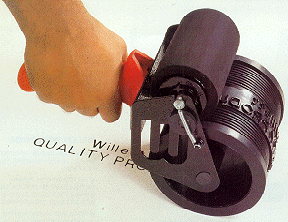Handy Coder
The HANDY CODER is a handoperated machine that can be used to mark or code on corrugated cartons, plywood, wooden crates, paper bags, cement / asbestos sheets, leather cloth or any substrate that absorbs ink.

FEATURES
Specifications
THE HANDY CODER
The HANDY CODER is a handoperated machine that can be used to mark or code on corrugated cartons, plywood, wooden crates, paper bags, cement / asbestos sheets, leather cloth or any substrate that absorbs ink.
A non-porous variant can also be used to mark on nonabsorbent substrates such as metal and plastic drums, HDPE woven sacks etc.
The Handy Coder can effectively mark on an area 95 mm in width and 355 mm in length.
TYPICAL USES
The Handy Coder is used to mark Batch No, Product Name, Date of Manufacture, Date of Expiry, Gross Weight, Net Weight, Destinations, Shipping Mark, Handling Instructions, Statutory Markings or any other information, as desired.
STURDY YET SLEEK
The Handy Coder has been designed to ensure that whilst it remains light weight it is sturdy enough to last continous & prolonged use.
VERSATILE IN USE
A message can be composed and marked within minutes. It needs only a few minutes of training for an unskilled worker to learn how to use the machine. There is therefore no need to maintain an inventory of stencils or pre-printed labels for your shippers.
SELF-INKING
The Handy Coder is equipped with a tension spring that returns the coder to its zero position after every stroke. In doing so the types get inked as they pass below the ink roller and it is ready for use again.
UNIFORM INK DISPENSATION
The ink roller is especially formulated to release a uniform quantity of ink for each impression. This is done through a proprietary process that controls pore size leading to smudge
– free, print like impressions.
The ink roller is easy to mount as shown here.
The ink roller comes with an adjustable eccentric washer that helps ensure uniform contact between the roller and types leading to even inking.
EASY RE-INKING
The inking roller can be easily recharged by immersing it in an ink container for 2/3 hours and then squeezing out any


